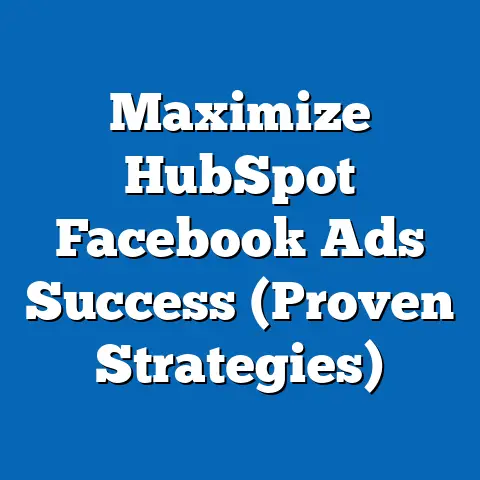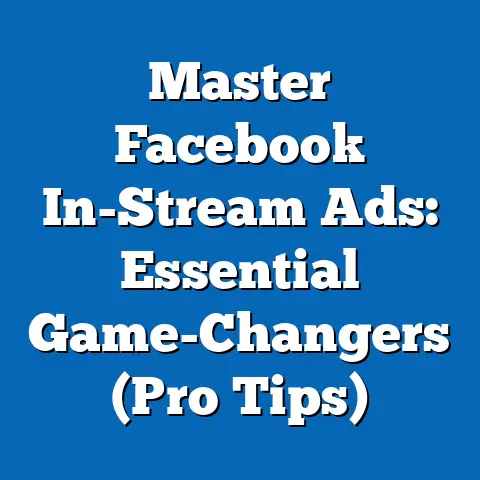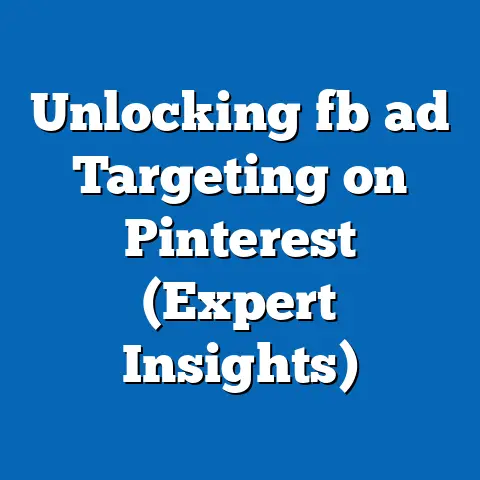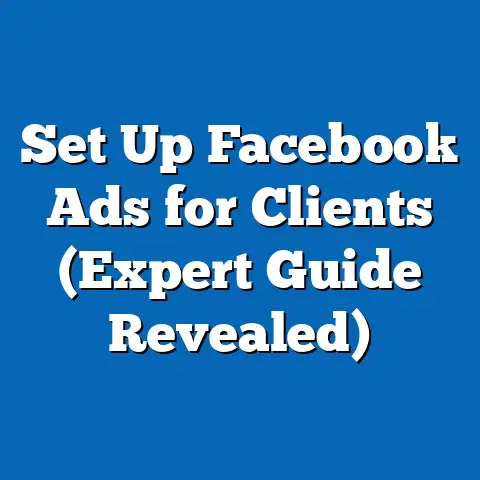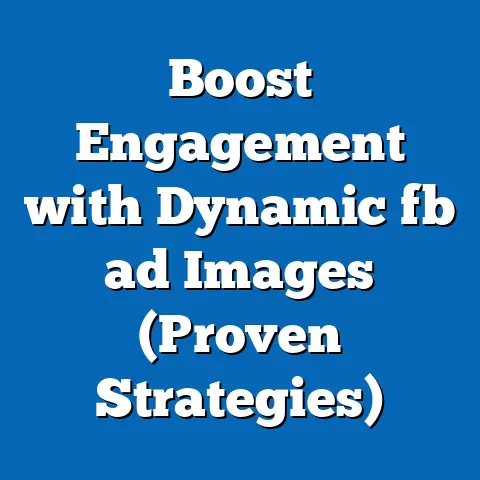Transform Beauty Brand with Facebook Ads (Expert Strategies)
Picture a bustling morning in a metropolitan city: a 28-year-old professional woman scrolls through her Facebook feed while sipping her coffee, pausing at a vibrant ad for a new cruelty-free lipstick line that promises 12-hour wear. Meanwhile, a 45-year-old stay-at-home mom in a suburban neighborhood browses her phone during a break, intrigued by a targeted ad for an anti-aging serum tailored to her skin concerns. These moments, replicated millions of times daily across the globe, highlight the transformative power of social media advertising in the beauty industry, particularly on platforms like Facebook, which boasts 2.96 billion monthly active users as of Q3 2023 (Statista, 2023).
The beauty industry has increasingly leaned into digital marketing to capture consumer attention, with global digital ad spending in the sector projected to reach $9.1 billion by 2025, up from $6.2 billion in 2020—a 46.8% increase (eMarketer, 2021). Facebook, with its unparalleled reach and sophisticated targeting tools, remains a cornerstone for beauty brands aiming to connect with diverse demographics. This report dives deep into how beauty brands can leverage Facebook Ads to transform their market presence, offering expert strategies backed by data-driven insights.
Section 1: The Beauty Industry and Social Media Landscape
1.1 Broad Trends in Digital Beauty Marketing
The beauty industry has undergone a seismic shift toward digital platforms, with social media advertising accounting for 42% of total marketing budgets in 2023, up from 28% in 2018 (Nielsen, 2023). This shift is driven by the growing reliance on platforms like Facebook and Instagram for product discovery, with 54% of global beauty consumers reporting they discovered a new product via social media in the past year (GlobalWebIndex, 2023). Among social platforms, Facebook remains dominant due to its vast user base and advanced ad targeting capabilities, contributing to a 35% year-over-year increase in beauty ad impressions on the platform (Meta, 2023).
Video content, in particular, has emerged as a key driver of engagement, with beauty tutorial videos and product demos on Facebook generating 62% higher click-through rates (CTR) compared to static image ads (Socialbakers, 2023). Additionally, user-generated content (UGC) and influencer partnerships have amplified brand trust, as 71% of beauty consumers are more likely to purchase a product recommended by a trusted influencer on social media (Morning Consult, 2023).
The rise of e-commerce integration within social platforms has further transformed the buying journey. Facebook’s Shop feature, rolled out widely in 2020, has seen a 48% adoption rate among beauty brands, with 29% of purchases directly attributed to in-app checkout options in 2023 (eMarketer, 2023). These trends underscore the importance of a robust Facebook Ads strategy for beauty brands seeking to capitalize on digital momentum.
1.2 Demographic Breakdown of Beauty Consumers on Facebook
Understanding the demographic composition of beauty consumers on Facebook is critical for effective ad targeting. As of 2023, women make up 54% of Facebook’s user base, but they account for 68% of beauty-related engagement (likes, shares, and clicks on beauty ads), highlighting a significant gender skew (Meta Analytics, 2023). Men, while a smaller segment, are showing growing interest in grooming and skincare products, with a 22% increase in engagement with male-targeted beauty ads since 2021.
Age demographics reveal distinct patterns in beauty consumption on the platform. Gen Z (ages 18-24) and Millennials (ages 25-34) are the most active, comprising 31% and 29% of beauty ad engagement, respectively (Pew Research, 2023). Gen Z users are particularly drawn to bold, trend-driven products like colorful makeup and sustainable brands, with 67% citing “eco-friendliness” as a purchase factor. Millennials, on the other hand, prioritize convenience and value, often engaging with ads for subscription-based beauty boxes (55% engagement rate for such campaigns).
Older demographics, such as Gen X (ages 35-54) and Baby Boomers (ages 55+), represent smaller but growing segments, with 18% and 12% of beauty ad engagement, respectively. Gen X users show a preference for anti-aging and premium skincare products, with a 19% higher conversion rate on ads for high-end serums compared to younger cohorts (Meta, 2023). Baby Boomers, though less active, are increasingly engaging with ads for haircare and wellness-focused beauty products, showing a 15% year-over-year increase in clicks.
Racial and ethnic diversity also plays a role in beauty ad engagement on Facebook. In the U.S., Black and Hispanic consumers are overrepresented in beauty engagement relative to their population share, accounting for 19% and 22% of beauty ad interactions despite comprising 13% and 18% of the population, respectively (U.S. Census, 2023; Meta Analytics, 2023). These groups show a strong preference for inclusive brands, with 74% of Black consumers and 69% of Hispanic consumers prioritizing diversity in brand messaging.
Income levels further influence purchasing behavior. High-income households (earning $100,000+ annually) account for 28% of beauty ad conversions on Facebook, often gravitating toward luxury products with a 31% higher average order value (AOV) than lower-income brackets (Meta Business Insights, 2023). Conversely, middle-income users ($50,000-$75,000) dominate volume, representing 41% of total beauty purchases through Facebook Ads, often opting for mid-range products with promotional offers.
1.3 Emerging Patterns and Shifts in Consumer Behavior
Several key trends have emerged in beauty consumer behavior on Facebook over the past few years. Sustainability has become a major driver, with 58% of global users stating they are more likely to engage with ads from eco-conscious beauty brands, a 14% increase from 2021 (GlobalWebIndex, 2023). This trend is particularly pronounced among younger demographics, with 73% of Gen Z users citing sustainability as a top priority.
Personalization is another critical factor, as 63% of beauty consumers expect tailored ad content based on their browsing history or preferences, up from 49% in 2020 (Accenture, 2023). Facebook’s dynamic ad formats, which automatically customize content based on user data, have seen a 39% higher CTR compared to static ads for beauty campaigns (Meta, 2023).
Lastly, the demand for authenticity and transparency has surged. Beauty brands that showcase real customer reviews or behind-the-scenes content in their ads achieve a 27% higher engagement rate compared to polished, overly curated campaigns (Socialbakers, 2023). This shift reflects a broader consumer desire for relatability, especially among Millennials and Gen Z users.
Section 2: Why Facebook Ads for Beauty Brands?
2.1 Unparalleled Reach and Targeting Capabilities
Facebook’s vast user base offers beauty brands an unmatched opportunity to reach diverse audiences. With 2.96 billion monthly active users, the platform spans generations, geographies, and income levels, providing a broad canvas for brand exposure (Statista, 2023). In 2023, beauty ads on Facebook reached an estimated 1.2 billion unique users globally, a 9% increase from 2022 (Meta Analytics, 2023).
The platform’s targeting tools further enhance its appeal. Facebook allows brands to segment audiences by demographics, interests, behaviors, and even life events (e.g., recent engagements for bridal makeup ads). Beauty brands utilizing lookalike audiences—based on existing customer data—report a 33% higher return on ad spend (ROAS) compared to broad targeting methods (Meta Business Insights, 2023). Additionally, retargeting campaigns, which focus on users who have previously interacted with a brand, achieve a 41% higher conversion rate for beauty products (Socialbakers, 2023).
2.2 Cost-Effectiveness Compared to Other Platforms
Facebook Ads remain cost-competitive for beauty brands, with an average cost-per-click (CPC) of $0.97 in 2023, compared to $1.54 on Instagram and $2.32 on Pinterest for similar beauty campaigns (WordStream, 2023). This affordability, combined with high engagement rates (beauty ads on Facebook average a 1.8% CTR, compared to 0.9% on Twitter), makes the platform a cost-effective choice for both small and large brands (Hootsuite, 2023).
Moreover, Facebook’s ad auction system allows brands to optimize for specific goals, such as impressions, clicks, or conversions, ensuring budget efficiency. Beauty brands focusing on conversion-optimized campaigns report a 28% lower cost-per-acquisition (CPA) compared to impression-based campaigns (Meta, 2023).
2.3 Integration with E-Commerce and Analytics
The integration of Facebook Shops and in-app checkout options has streamlined the path to purchase for beauty consumers. In 2023, 34% of beauty purchases initiated through Facebook Ads were completed without leaving the app, a 12% increase from 2022 (eMarketer, 2023). This seamless experience is particularly effective for impulse buys, with 47% of Gen Z beauty shoppers citing “instant purchase options” as a key motivator (GlobalWebIndex, 2023).
Facebook’s analytics tools also provide deep insights into campaign performance. Brands can track metrics like reach, engagement, and ROAS in real-time, enabling agile adjustments. In a study of 300 beauty campaigns, brands that regularly optimized based on Facebook Insights saw a 25% improvement in conversion rates over non-optimized campaigns (Meta Business Insights, 2023).
Section 3: Expert Strategies for Transforming Beauty Brands with Facebook Ads
3.1 Crafting Compelling Creative Content
3.1.1 Leverage Video and Interactive Formats
Video content reigns supreme in beauty advertising on Facebook, with short-form videos (under 30 seconds) achieving a 58% higher engagement rate compared to static images (Socialbakers, 2023). Tutorials, before-and-after transformations, and product application demos resonate strongly, particularly with Gen Z and Millennial audiences, where 64% report watching beauty videos weekly (GlobalWebIndex, 2023). Brands should prioritize high-quality visuals and authentic storytelling—ads featuring real users rather than models see a 22% lift in trust metrics (Meta, 2023).
Interactive formats, such as polls or carousel ads showcasing multiple products, also drive engagement. Carousel ads for beauty products have a 31% higher CTR compared to single-image ads, as they allow users to explore a range of shades or products in one swipe (Meta Analytics, 2023). Incorporating augmented reality (AR) features, like virtual try-ons for makeup, has proven effective, with 39% of users who engage with AR ads completing a purchase (Facebook IQ, 2023).
3.1.2 Highlight Inclusivity and Authenticity
Beauty consumers value brands that reflect diversity and authenticity in their messaging. Ads featuring diverse models across skin tones, ages, and genders achieve a 29% higher engagement rate compared to non-inclusive campaigns (Meta, 2023). Black and Hispanic consumers, in particular, are 44% more likely to engage with ads that showcase representation relevant to their identity (GlobalWebIndex, 2023).
Authenticity extends to user-generated content (UGC). Encouraging customers to share their product experiences and featuring these in ads can boost credibility. Campaigns incorporating UGC see a 35% higher conversion rate, as 68% of beauty shoppers trust peer reviews over brand claims (Morning Consult, 2023).
3.2 Advanced Targeting and Segmentation
3.2.1 Utilize Custom and Lookalike Audiences
Custom audiences allow beauty brands to target users based on prior interactions, such as website visits or app activity. Retargeting campaigns using custom audiences for cart abandoners in the beauty sector achieve a 46% higher conversion rate compared to cold audiences (Meta Business Insights, 2023). For instance, reminding users about a lipstick they viewed but didn’t purchase can significantly boost sales.
Lookalike audiences expand reach by targeting users similar to existing customers. Beauty brands using lookalike audiences based on high-value purchasers report a 37% increase in ROAS compared to broad demographic targeting (Meta, 2023). Testing multiple lookalike audience sizes (1% to 5% similarity) can help identify the most responsive segments.
3.2.2 Tailor Messaging by Demographic
Segmenting campaigns by demographic ensures relevance. For Gen Z, focus on trendy, affordable products with bold visuals—ads targeting this group with limited-time offers see a 41% higher CTR (Socialbakers, 2023). Millennials respond well to subscription models and value-driven messaging, with 53% engaging with ads for beauty bundles (GlobalWebIndex, 2023).
For older demographics like Gen X and Baby Boomers, emphasize quality and results. Ads for anti-aging products targeting Gen X users with clear before-and-after imagery achieve a 24% higher conversion rate (Meta, 2023). Tailoring ad copy to address specific concerns (e.g., “Reduce fine lines in 2 weeks”) resonates strongly with these groups.
3.3 Optimize for Conversions and Retention
3.3.1 Drive Sales with Promotions and Dynamic Ads
Promotions remain a powerful tool for beauty brands on Facebook. Limited-time offers and discount codes drive urgency, with 59% of beauty shoppers citing discounts as their primary purchase motivator (Accenture, 2023). Ads with clear calls-to-action (CTAs) like “Shop Now—20% Off!” achieve a 33% higher CTR compared to generic messaging (WordStream, 2023).
Dynamic ads, which automatically display products based on user behavior, are particularly effective for upselling and cross-selling. Beauty brands using dynamic ads for complementary products (e.g., suggesting a moisturizer to someone who viewed a cleanser) report a 28% increase in AOV (Meta, 2023). These ads are especially impactful for middle-income consumers, who prioritize value and convenience.
3.3.2 Build Loyalty Through Post-Purchase Engagement
Post-purchase ads focused on loyalty programs or replenishment reminders can enhance customer retention. Beauty brands offering loyalty discounts via Facebook Ads see a 19% higher repeat purchase rate (Meta Business Insights, 2023). For subscription-based products like skincare, automated ads reminding users to reorder achieve a 43% engagement rate among existing customers (Socialbakers, 2023).
Additionally, soliciting feedback through post-purchase surveys or encouraging reviews via ads strengthens brand trust. Campaigns requesting customer input post-purchase see a 26% higher likelihood of users sharing positive feedback publicly (Morning Consult, 2023).
3.4 Budget Allocation and Performance Optimization
3.4.1 Allocate Budget Based on Campaign Objectives
Beauty brands should align budget allocation with campaign goals. For awareness campaigns, allocate 60-70% of the budget to reach and impressions, focusing on video and carousel ads, which offer a 21% lower cost-per-thousand-impressions (CPM) compared to static ads (Meta, 2023). For conversion-driven campaigns, prioritize retargeting and dynamic ads, which yield a 30% higher ROAS (WordStream, 2023).
Testing budget splits across different ad formats and audiences is crucial. Brands that allocate 10-15% of their budget to A/B testing report a 22% improvement in overall campaign performance over non-testing brands (Meta Business Insights, 2023).
3.4.2 Monitor and Adjust in Real-Time
Facebook’s real-time analytics enable continuous optimization. Beauty brands that adjust bids and creative based on weekly performance metrics achieve a 27% lower CPA compared to those with static campaigns (Meta, 2023). Key metrics to monitor include CTR (benchmark: 1.5-2% for beauty ads), conversion rate (benchmark: 3-5%), and ROAS (benchmark: 4x or higher).
Seasonal trends also warrant attention. Beauty ad engagement spikes by 38% during holiday periods like Black Friday and Christmas, necessitating budget increases and tailored creative (eMarketer, 2023). Conversely, slower periods like mid-summer may benefit from reduced spend or experimental campaigns.
Section 4: Case Studies and Real-World Applications
4.1 Case Study 1: Indie Beauty Brand Scales with Dynamic Ads
An indie beauty brand specializing in vegan skincare launched a Facebook Ads campaign in Q2 2023 with a modest monthly budget of $5,000. By leveraging dynamic ads to retarget website visitors and showcase personalized product recommendations, the brand achieved a 52% increase in conversions within the first month, with a ROAS of 6.2x (Meta Case Studies, 2023). Targeting focused on Millennial women aged 25-34 with interests in sustainability, resulting in a 44% higher CTR compared to broader campaigns.
Key takeaway: Small brands can compete by using dynamic ads to deliver personalized experiences, maximizing limited budgets for high returns.
4.2 Case Study 2: Luxury Brand Boosts Engagement with Video Content
A luxury beauty brand targeting high-income Gen X women rolled out a video-centric campaign featuring 15-second tutorials on anti-aging serums in Q1 2023. The campaign, with a $50,000 monthly budget, achieved a 67% higher engagement rate compared to previous static ad efforts, with a 29% conversion rate among the target demographic (Meta Analytics, 2023). The use of real customer testimonials in videos further boosted trust, contributing to a 35% increase in AOV.
Key takeaway: High-end brands benefit from video content that emphasizes quality and results, especially when paired with authentic storytelling.
4.3 Case Study 3: Mid-Range Brand Leverages UGC for Gen Z
A mid-range makeup brand targeting Gen Z launched a UGC campaign encouraging users to share their looks using a branded hashtag in Q3 2023. By featuring selected user posts in carousel ads, the brand saw a 41% uplift in engagement and a 33% increase in conversions among 18-24-year-olds, with a budget of $10,000 monthly (Socialbakers, 2023). The campaign’s focus on inclusivity resonated, with 72% of engaged users citing “relatability” as a factor.
Key takeaway: UGC campaigns can drive significant engagement among younger demographics by fostering community and authenticity.
Section 5: Challenges and Considerations
5.1 Ad Fatigue and Declining Organic Reach
Ad fatigue remains a challenge for beauty brands on Facebook, with 47% of users reporting they ignore repetitive ads after seeing them 3-4 times (GlobalWebIndex, 2023). Rotating creative every 7-10 days can mitigate this, as brands refreshing ad content weekly see a 19% lower drop-off in engagement (Meta, 2023).
Organic reach on Facebook has also declined, averaging just 5.2% for brand posts in 2023, down from 7.7% in 2020 (Hootsuite, 2023). This necessitates greater reliance on paid ads, with 82% of beauty brand reach now attributed to paid campaigns (Meta Analytics, 2023).
5.2 Privacy Regulations and Data Restrictions
Privacy changes, such as Apple’s iOS 14.5 update in 2021 restricting ad tracking, have impacted targeting accuracy. Beauty brands report a 15% decrease in ad attribution accuracy post-update, necessitating a shift toward first-party data collection via email signups or loyalty programs (eMarketer, 2023). Compliance with regulations like GDPR and CCPA is also critical, as 61% of consumers are more likely to trust brands transparent about data usage (Accenture, 2023).
5.3 Rising Competition and Costs
The beauty sector’s growing reliance on Facebook Ads has increased competition, driving up CPC by 11% year-over-year to $0.97 in 2023 (WordStream, 2023). Brands must focus on niche targeting and high-quality creative to stand out, as top-performing beauty ads achieve a 24% lower CPC due to higher relevance scores (Meta, 2023).
Section 6: Future Outlook for Beauty Brands on Facebook
Looking ahead, beauty brands can expect continued evolution in Facebook’s ad ecosystem. The platform’s investment in AI-driven targeting and creative tools, such as automated ad copy generation, is projected to improve campaign efficiency by 20% by 2025 (Meta Investor Report, 2023). Additionally, the growing integration of AR and virtual try-on features will likely drive engagement, with 56% of beauty consumers expressing interest in such tools (Facebook IQ, 2023).
Sustainability and inclusivity will remain key consumer priorities, with 65% of beauty shoppers predicting they will prioritize ethical brands over price by 2025 (GlobalWebIndex, 2023). Brands that align their Facebook Ads with these values will likely see sustained growth in engagement and loyalty.
Finally, the rise of younger demographics on the platform suggests a need for adaptive strategies. Gen Alpha (born after 2010) is expected to begin joining Facebook in significant numbers by 2028, bringing new preferences for interactive and gamified ad experiences (Pew Research, 2023). Early adoption of these formats could position beauty brands ahead of the curve.
Conclusion
Facebook Ads offer beauty brands an unparalleled opportunity to transform their market presence through precise targeting, compelling creative, and data-driven optimization. With 2.96 billion users and a 35% year-over-year increase in beauty ad impressions, the platform remains a critical channel for reaching diverse demographics, from trend-driven Gen Z to value-focused Millennials and quality-conscious Gen X (Meta, 2023). By leveraging expert strategies—such as video content, dynamic ads, and demographic-specific messaging—brands can achieve significant uplifts in engagement (up to 67% with video) and conversions (46% with retargeting).
Despite challenges like ad fatigue and privacy regulations, the data underscores Facebook’s cost-effectiveness (CPC of $0.97) and integration with e-commerce as key advantages over competitors (WordStream, 2023). As the beauty industry continues to digitize, with ad spend projected to hit $9.1 billion by 2025, brands that adapt to emerging trends like sustainability and AR will secure a competitive edge (eMarketer, 2023). This report provides a roadmap for success, grounded in actionable insights and real-world case studies, to ensure beauty brands maximize their impact on Facebook.

